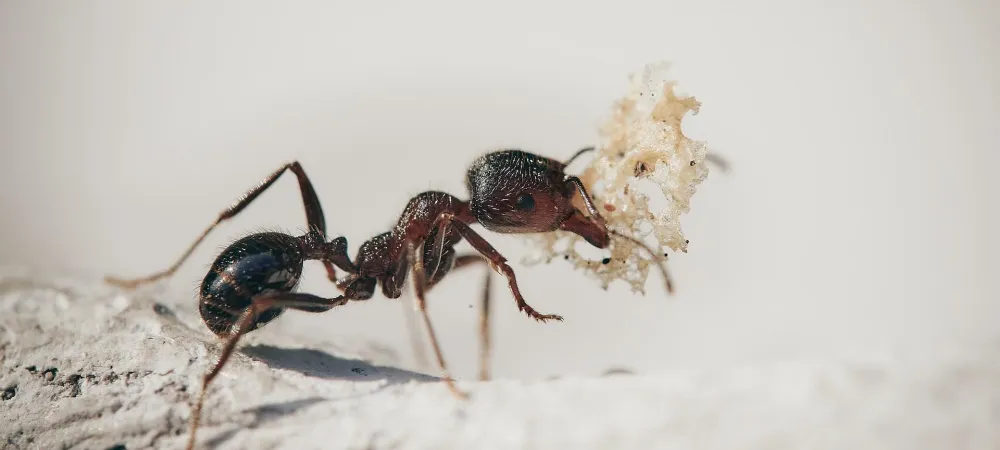How to Get Rid of Ants in The Kitchen

Ants are common household pests, and they love sugary, syrupy foods, so when they get indoors, they usually head straight for your kitchen. Once ants get into your kitchen, it is hard to get rid of them. Thankfully, there are some ant control techniques you can use to prevent and eliminate these kitchen pests.
There are over 12,000 known species of ants found worldwide. Only around 700 species live in the United States. Here in Southern California, there are 5 species of ants that are most commonly found in homes.
Argentine Ant Identification
Argentine ants are the most persistent and troublesome ant that invades houses in Southern California. This is due to their tiny size and their ability to get through any sized cracks. The Argentine Ant lives in shallow galleries in the ground, often only a few inches deep. One colony can have multiple queens and grow pretty fast, displacing other native types of ants. Whenever a queen leaves and takes some workers with her, other colonies quickly spring up.
Pharaoh Ant Identification
Pharaoh ants are yellowish to brown in color. They measure less than 1/16th inch. Foods like meat and sweets are especially tempting to these ants, especially fatty and greasy foods. Their unusual name comes from their original habitat in Egypt. Pharaoh ants nest inside buildings near food in warm and inaccessible locations. Colonies can have hundreds of thousands of workers and several queens.
Harvester Ant Identification
A California harvester ant measures in at 1/4 inch in length and is red in color. They build their nests underground with a small mound at the opening. The harvester ant is named for its affinity for seeds and grains as a main source of food. These ants tend to be aggressive and will sting people and animals that get too close to their nest.
Thief Ant Identification
Thief ants are about 1/16th of an inch, and are a pale brownish color. They can get into houses easily to find food and water because of their size. They like meat, cheese, and greasy food. They'll also eat dead bugs. Thief ants build their nests in dirt galleries, and pillage other ant colonies for food, which is how they got their name. Thief ants will also build nests inside walls, cabinets, cracks, and crevices. A colony may contain from a few hundred to a few thousand ants.
How Are Ants Getting in My Kitchen?
When you see tiny ants in your kitchen, they are in search of one thing; a food supply. Most ant species are attracted to the sugar and fats in food. They also are on the lookout for water, which can be easily found in the kitchen or bathroom.
The ants enter your home through cracks in your windows, doorways, or floors looking for food and water to replenish their colonies. While ants are usually most active in Spring and Summer, the Southern California weather allows ants to be active throughout the entire year, so it’s important to always be aware of openings around your kitchen.
Once a worker ant has found a reliable source of food, they will leave a path of pheromones for other ants to follow. That’s why you'll see lines of ants marching across your counter and up your cupboards. For finding the source of the ants as well as eliminating them, it is important to understand this behavior.
Methods To Remove Ants From Kitchen
If you are having issues with ants in your kitchen, here are some helpful tips to help you get rid of ants and prevent them from coming back.
Identify Entry Points
Follow the line of ants to find out where they’re coming from such as:
- Old caulk lines around windows
- Torn screens
- Cracks in foundation
- Cracks in the floor
- Air vents
During your search for the colony, take note of where the ants are entering and leaving your kitchen. Use this entry point to place bait if needed and observe the colony. If you're certain the nest has been mostly eliminated, you can start ant-proofing your kitchen once the bait has had a chance to work. Use caulk or joint compound to seal any cracks or crevices.
Practice Cleanliness Routines
Ants are attracted to the smells from our kitchen and if your kitchen is dirty, it could attract ants like a dinner bell. Make sure there are no dirty dishes left in the sink at the end of the day and make sure that the trash is taken out. Sweep and mop your floor so that there aren’t any crumbs lying around. You don’t want to leave anything out that might attract ants.
Properly Store Food
To prevent ants from smelling what’s in our pantry, place grains and baking materials in air-tight containers. Even pet food can attract ants so if your pet doesn’t finish their dinner make sure to put it away and store it in airtight containers.
Use Natural Solutions
Chemical pesticides may not be appropriate for ant control in your kitchen. Using a few simple household products, you can eliminate the stragglers after treating the ants at their source.
- Liquid dish soap: If you want to get rid of ants on your kitchen counters, just water with a few drops of dish soap. The soap breaks the surface tension and traps the ants, allowing you to wipe them away easily.
- Ground black or red pepper: Sprinkle pepper around baseboards and behind appliances.
- Peppermint: Mix 10 to 20 drops of peppermint essential oil with 2 cups of water in a clean plastic spray bottle. Spray the mixture around the baseboards and windows of your home.
- In a clean plastic spray bottle, mix 5 to 10 drops of tea tree oil with 2 cups of water. Apply the mixture around the house where you typically see ants. The mixture can also be applied to cotton balls and placed throughout your house.
- Lemon eucalyptus oil: Apply undiluted lemon eucalyptus essential oil to cotton balls. The cotton balls should be placed in areas of your home where you usually see ants. Make sure to replace the cotton balls on a weekly basis.
- White vinegar: Mix white vinegar with water in a 1-to-1 ratio to clean hard surfaces such as counters and floors. Spray the mixture directly on the ants and then wipe them up with a paper towel.
- Coffee grounds: Sprinkle freshly brewed coffee grounds on a paper plate or index card and leave them in areas where ants gather such as windows, pet bowls, and sinks.
- Boric acid: Make a solution of 1/2 teaspoon boric acid, 8 teaspoons sugar, and 1 cup warm water. Saturate cotton balls and place them in areas where you usually see ants.
- Borax: Mix 1 cup warm water with 1/2 teaspoon borax, 8 teaspoons sugar, and 1 teaspoon salt. Dissolve the sugar and borax in hot water by stirring. Saturate cotton balls and place them around your home in areas where you commonly see ants.
Professional Ant Control
Some infestations can get out of control quickly and are best left to a trusted ant exterminator. Luckily, the professional pest control providers at the bugman have the knowledge and experience to target even the largest ant colonies and make sure they don’t come back into your home. Give us a call today at 714-406-4949 or leave us a message on our site.

